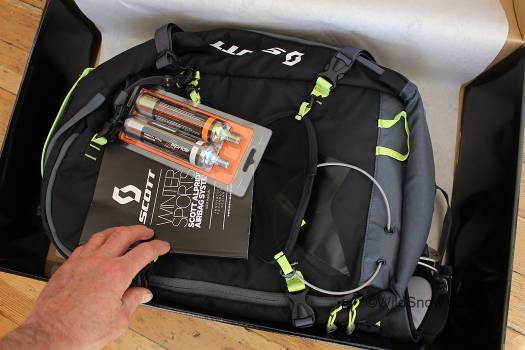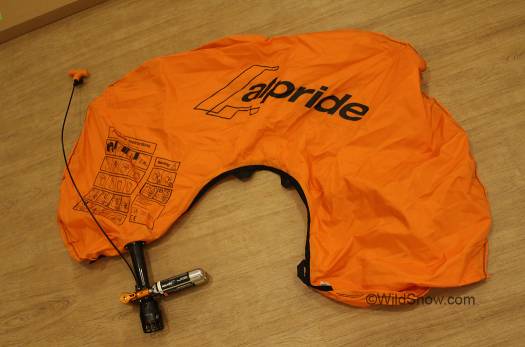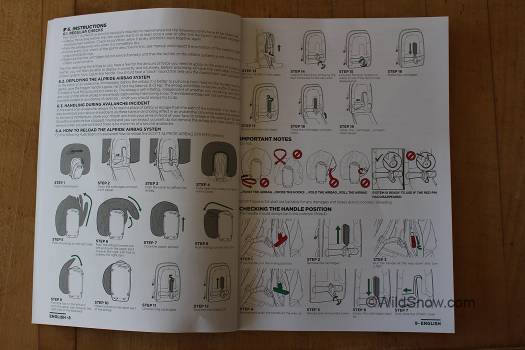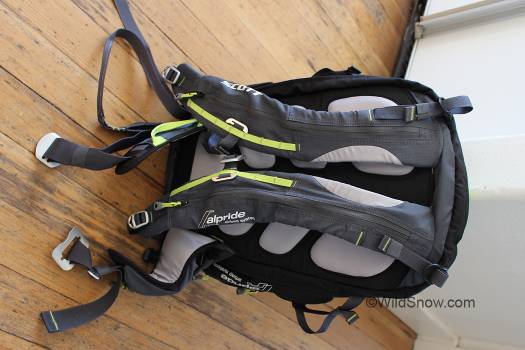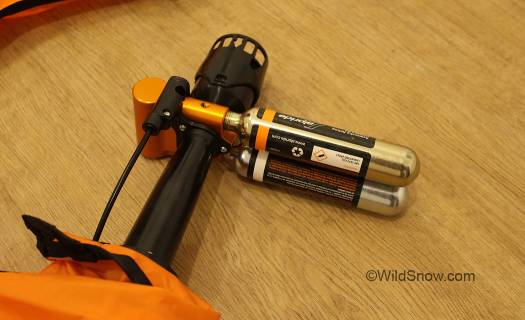Shop for Scott Alpride avalanche airbag pack.
We’ve been excitedly anticipating our review copy of the new Scott Alpride avalanche airbag backpack. Strengths: Below average weight for a balloon pack, nicely made, okay pricing, travel friendly, simple refill/renewal (buy another pair of blister packed cartridges).
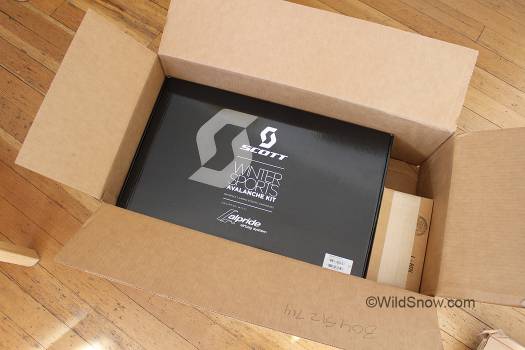
The fancy box in Scott black-on-black branding colors. The smaller box to right is an extra set of cartridges for our testing sample.
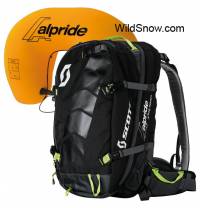
Stock image, but it shows the pack well compared to what we can do here at the office. Click all images to enlarge.
Scott’s names for these packs are confusing. Near as I can tell from their website, our 30 liter tester is called the “Air Free Alpride 30 Kit Pack.” What I think that means is this is an “Air Free” 30 liter Scott backpack model with the Alpride System installed. Makes sense, as the balloon system can be user extracted from the pack in about 5 minutes, and swaps into other Scott packs in about ten minutes (perhaps faster once you get used to it.) In any case, we’ll call this the Alpride 30 and be done with the epistemology.
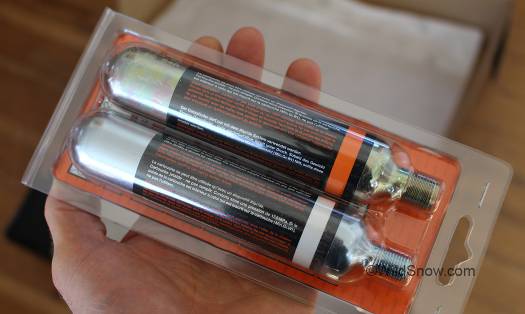
The cartridge set is what’s most interesting. They’re said to be the same thing used for inflatable PFDs. One holds 60 grams carbon dioxide, the other contains 26 grams argon. Ever curious, I immediately asked the Great Goog for “60 gram CO2 cartridges, where I found a few for around $20. As for argon, it’s apparently used as a wine preservative and cartridges are available on the open market (though most appear to lack threads). The pair of Alpride cartridges have different threads to prevent inserting in the wrong port when you set up the airbag plumbing. The CO2 cartridge is 5/8 inch fine thread (standard for motorcycle airbags), while the argon is 1/2 inch fine. It’ll be interesting to see how available these cartridges are online. I’ll do some test shopping immediately.”
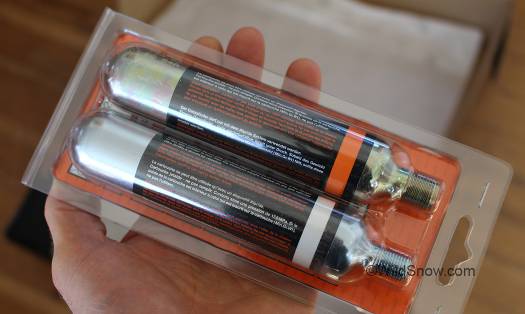
The cartridges. CO2 cartridge is standard issue for inflatable PFDs. Argon cartridge appears to be similar to those used in wine preservation systems. We’re hoping aftermarket availability will help keep costs down. The pair of cartridges weighs 450 grams.
For many of you, weight is the airbag pack issue you’re hoping Alpride makes progress with. Following are the specs straight from our scales.
Total weight of pack with airbag system (including dual gas cartridges) is 103 ounces, 2922 grams. That’s still light for an airbag ruck, but more than the pre-production weight of 2.2 kilo (2100 grams) we raved about last winter when we fondled this pack during the Scott press event at St. Anton. I’m not certain where the cellulite grew, probably on the production pack which is a bit over-designed with extra layers of fabric and overall beef. Or, perhaps we were actually testing the Alpride 20, which is indeed lighter. In any case, while this is one of the lighter airbag backpacks, due to things like optional carbon cartridges it’s impossible to come up with a clear weight winner.
Weight of airbag system as removed from Alpride pack, with the dual cartridges: 44.7 ounces (2.8 pounds) 1266 grams
Weight of Alpride 30 pack without airbag parts and pieces 58 ounces (3.6 pounds) 1656 grams.
As comparo, my medium-light daily touring pack weighs 37 ounces (2.3 pounds), 1058 grams. That means for me, when I carry the Alpride I’m hauling an extra 21 ounces, 595 grams — regardless of the airbag plumbing. Better minds than mine are on this, but I can’t help wondering if airbag packs really need to be that heavy. To be fair, you do need more beef in an airbag pack because it’s anchoring the balloon. More, Alpride has a back protector sheet (non removable). So you do get something for hauling those 595 grams. But still…I’d rather simply carry 1.3 pounds less weight.
So, continuing the comparo and naming names. We verified BCA’s Float 32 pack model at 108 ounces, 3062 grams. There are other airbag systems in that same weight class. In that sense Alpride is really not all that light. It’s only going to save you a few ounces over the BCA, which offers a bit more volume for the added mass. On the other hand, about 5 ounces when combined with other weight saving measures is significant. You be the judge.
Wrinkle in this is I’m told Alpride could perhaps motor on one cylinder (you mod the guts with a block-off plug on the argon port). I’m told if you leave out the Argon it inflates slightly slower but adequately using only a CO2 cartridge. In that case, you’re saving 7 ounces, 205 grams — making the Alpride mass at 2,717 grams. Still significantly above the 2.1 kilo weight we crowed about last winter, but quite good.
(Theoretical notes regarding experimentations with one cartridge. First thing, you won’t get full CO2 volume to the airbag if the cartridge temperature is -5 degrees centigrade (23 degrees F) or below. Storing the unit indoors and insulating the cylinder along with a chemical heat pack would perhaps be the solution, albeit fiddly. You would configure by using a standard PFD 60 gram refill cartridge (1/2 inch thread) attached to the argon port, and block off the CO2 port with a plug. The plug would seal on the 0-ring in the threaded port socket and have have a hole in the center for the firing pin, otherwise the unit won’t fire and you would possibly damage the pin mechanism. )
In terms of weight mods, the trigger loader that comes attached to the pack with a string (see photo below) can be left at home; it weighs 20 grams. The helmet carrier is also removable and weighs 9 grams. We can see several obvious razor blade mods as well. We’ll test the pack in stock for for a while, then bring out the knife and see what the designers should have left on the cutting room floor instead of our shoulders.
In any case, Alpride is on the light side but not miraculous in terms of mass. So what could put this pack over the top for your shopping choice?
If you airline travel with your ski gear, you know that flying with an airbag backpack is a hassle. Enter Alpride. Scott says their system can airline travel by simply having the cartridges in their installed position with an available regulations document you print out and include for the inspectors to read (assuming they’re literate). Unfortunately, the Alpride user manual doesn’t totally clear up the travel issue. On page English-10 it gives conflicting instructions. First, it reads “…put your airbag backpack in your travel bag…check in your travel bag…,” then a few lines later it reads “put…your cartridge, activation handle and backpack in your carry-on luggage.” Something is off, hopefully Scott will correct — I’m planning on taking this thing to Europe!
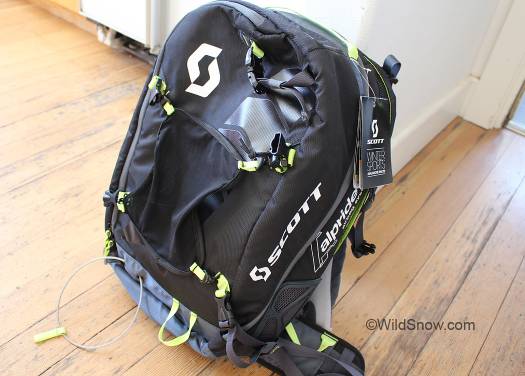
Alpride 30 at WildSnow HQ. Note the helmet carrier, ice tool loop, etcetera. All the standard stuff is there, and nicely done.
Beyond saving a few ounces and easier travel, my favorite thing about Alpride is how nicely it’s made. Nothing seems to have escaped the brains of Scott’s industrial designers. An elegant system for diagonal ski carry utilizes a simple cable loop and upper strap. The interior green color is odd at first glance, but bright, making it easy to find things inside your pack when it’s closed up. Yes, Alpride is a panel loader. Groan. But I’ll live with it (and admit that panel loaders might be better as airbag packs due to how the airbag needs to mount). The buckles are beautiful aluminum creations. A gear loop is present on the right hipbelt, accessory pocket on the left. Hydration sleeve is included in right shoulder strap. Back frame is said to be a spine protector.
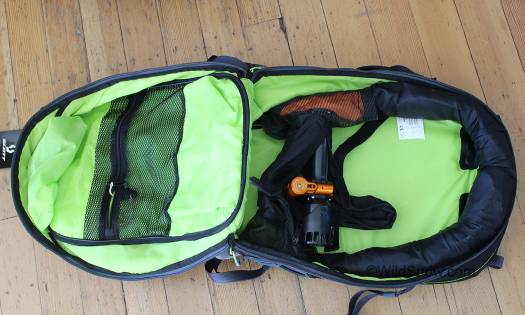
Panel loader, opened. While I like panel loaders about as much as I like Vladimir Putin, the interior color is nice for visibility as compared to a black pack interior.
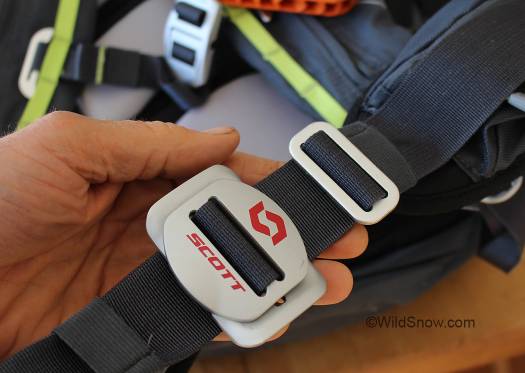
I think I saw a Scott employee in Europe using this waist belt buckle for his dress up belt. It’s that nice, and reasonably easy to operate.
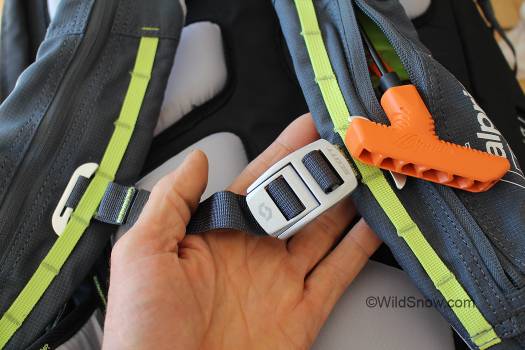
Sternum strap buckle is of equal aesthetics, and obviously quite strong. Since airbag packs are designed to stay on no matter what — even if you’re hanging in a tree or crevasse getting strangled, so be sure to use your crotch strap most of the time to keep the pack safely where it belongs no matter where you end up.
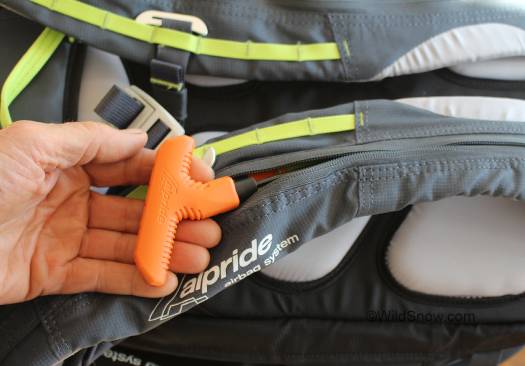
Trigger handle looks “factory,” stows nicely in the shoulder strap and threads out through a hole in the backboard for removal of the airbag system.
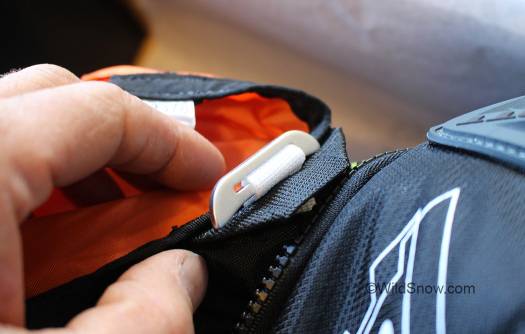
Removable balloon is anchored to pack with these aluminum keyhole tabs. They’re difficult to remove; I had to use pliers, but they do come out.
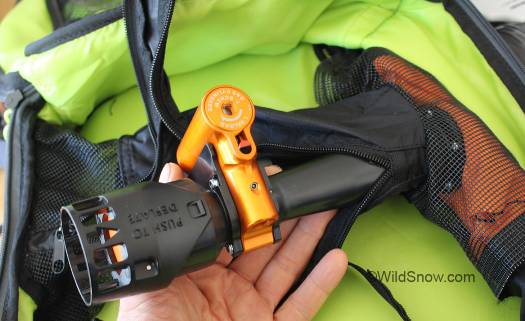
Main plumbing. The orange anodized aluminum unit is the cartridge mount and spring loaded trigger. Black plastic to left is the venturi that uses power from compressed gas to such extra air in for more fill volume.
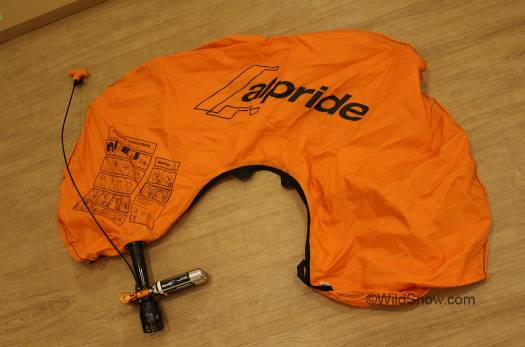
Deflated balloon removed from backpack. One wonders if an aftermarket superlight balloon could be made from Dyneema type fabric.
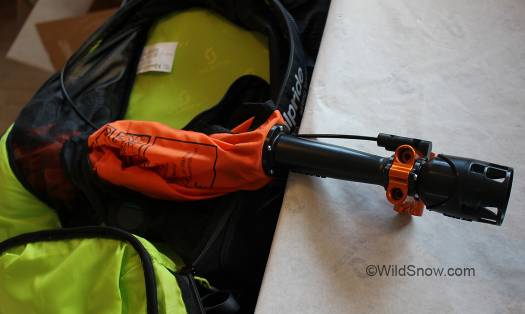
Removing the airbag system from pack requires pulling the airbag through a fairly small hole, but it does come out. Reversing the procedure is a bit tedious and could be improved. Most users will probably never need to remove the system, but I like the concept of owning a lighter/smaller backpack for easy days and swapping the plumbing between packs.
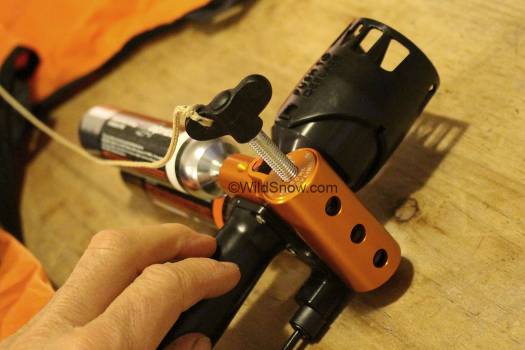
Alpride trigger system is a spring loaded firing pin configuration that punctures the cartridges when you pull the trigger handle. You cock the trigger by screwing in this simple threaded loader. The loader is attached to the pack and weighs 20 grams. It apparently can be left at home if you’re not planning on renewing cartridges in the field.
Check out Alpride on the Scott Website.
I larded in the following PR video, and despite the Euro-techno flavor, it does inform.
Shop for Scott Alpride avalanche airbag pack.
WildSnow.com publisher emeritus and founder Lou (Louis Dawson) has a 50+ years career in climbing, backcountry skiing and ski mountaineering. He was the first person in history to ski down all 54 Colorado 14,000-foot peaks, has authored numerous books about about backcountry skiing, and has skied from the summit of Denali in Alaska, North America’s highest mountain.

